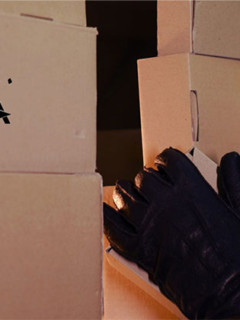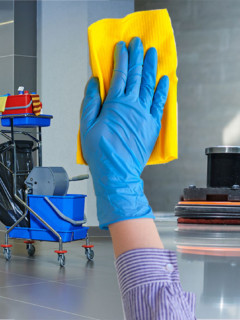Due to the COVID-19 pathogen, almost nothing is currently under discussion as much as inhalation and its consequences. In fact, deep breathing has a relaxing effect, helps to think clearly again and occasionally prevents a rash utterance. A person takes 20,000 breaths a day – that’s about 6,600 times during a working day. No wonder, then, that the Ministry of Health has now recommended that respirators be worn in public places (at least wherever the minimum distance cannot be kept or can only be kept with difficulty) in view of the way COVID-19 is transmitted via the respiratory tract. But not all respirators are the same.
Respiratory protection at the workplace thanks to disposable masks
For many of our customers, for example in the construction industry, in painting and varnishing companies, medical or chemical laboratories, in the food industry and agriculture, the subject of respiratory protection is part of everyday working life. This ranges from completely self-contained breathing apparatus (for operations with less than 17% oxygen by volume or for toxic gases) to full-face masks (for protection against gases and vapours, e.g. for fire brigade operations) and the particle filtering half mask. This dust mask, also called FFP (filtering face piece), covers the nose and mouth and, depending on the design, protects against the inhalation of various particles as well as aqueous or oily aerosols.The total leakage and the MAK play a central role here. Total leakage is the sum of all leaks from the face, exhalation valve and filter passage. MAK (Maximum Workplace Concentration) is the maximum permissible concentration of a substance in the air breathed at the workplace at which no adverse health effects are to be expected. Even with a daily working time of 8 hours, a maximum of 40 hours per week (42 hours for shift work), there must be no health hazards.
There are three different FFP classes, their protective function is standardised according to EN149:
| Surgical mask | FFP 1 mask | FFP 2 mask | FFP 3 mask | |
|---|---|---|---|---|
| Protection level | Protects others from droplets in the exhaled air of the wearer |
Filtering capacity 78 %, Against fine dust (up to 4 times the MAK value*) |
Filter capacity 92 %, Against toxic fine dust (up to 10 times the MAK value*) |
Filter capacity 98 %, Against fine dust and very toxic dust (up to 50 times the MAK value*) |
| Area of application | Hospitals and care facilities, Use in public as a preventive measure |
Construction industry, food industry | Metal and chemical industry, Mining |
Chemical and pharmaceutical industry, Metal industry |
| Pollutants | Limited barrier effect with regard to mutual infection |
Non-toxic substances: cotton, coal, ferrous metals etc.The additional marking “D” on the filter class on the filter class means that the mask meets the European standard Dolomite dust storage test in accordance with the European standard. |
Harmful substances: Dust, smoke, aerosols Dust, smoke, aerosolsThe additional marking “D” on filter class on the filter class means that the mask meets the standard the Dolomite dust storage test according to the European standard |
Toxic, harmful substances: Dust, smoke, aerosols, viruses, bacteria, fungal spores, radioactive substancesThe additional mark “D” on the on the filter class means that the mask meets the standard the dolomite dust storage test according to the European standard |
*MAK value (Maximum workplace concentration): Indicates the maximum permissible concentration of a substance as a gas, vapour or suspended matter in the air at the workplace (for an 8-hour working day as a rule).
Focus on surgical masks
A surgical mask is a medical device and complies with EN 14683+C1:2019. It is a disposable device that is disposed of after each use. Recommended wearing time: 4 hours.
Focus on FFP masks
FFP- masks comply with the European standard EN149-2001+A1:2009. Whether cupped or collapsible, with or without a valve, the effectiveness of the mask remains the same for the wearer. The valve provides better breathability and reduces the temperature inside the mask. It lets air through when exhaling and closes again when inhaling. Recommended wearing time: 8 hours.
Shell mask or foldable mask?
Matter of taste. A shell mask is shaped and rigid, which makes it quicker to put on. A foldable mask is flexible, bendable and space-saving. It also adapts to any face shape.
Disposable or reusable mask?
If the respiratory protection mask is only needed occasionally for individual activities, the use of disposable masks is recommended. These are simply replaced as soon as breathing becomes more difficult. Depending on the concentration of particles against which the mask is to provide protection (dust, smoke, aerosols, viruses, bacteria, fungal spores…), the mask provides protection for up to 8 hours – or the 6,600 breaths calculated above.Disposable mask with valve – or without?
Whether it is advisable for you to use a respirator with a valve depends mainly on how long you wear it and the type of work you do. The valve facilitates the escape of breathable air and is therefore perceived as more comfortable during longer periods of wear or during strenuous activities with increased breathing frequency. This results in a permanently cool and dry climate inside the mask and has another major advantage when safety goggles are worn in addition to the protective mask: Since the moist breathing air only escapes via the valve, fogging of the goggles is significantly minimised.Both variants, with and without a valve, offer optimal protection, as the valve membrane closes completely airtight when inhaled, simply by taking a breath.
Protective masks and the coronavirus
Respiratory protection masks are primarily produced in Asia, especially in China, this fact and the very high demand worldwide cause the current bottlenecks in replacement. Protective masks are urgently needed above all in the health sector, for medical and nursing staff. Two types of masks are primarily used in hospitals: simple surgical masks made of fleece, which are used to protect patients from the saliva of doctors and staff during an operation, and protective masks of classes FFP2 and FFP3. Since the coronavirus is relatively small, only these FFP masks offer protection against infection with the coronavirus.On its website, the Robert Koch Institute (RKI) also recommends wearing a mouth-nose protection wherever the safe distance cannot be maintained (e.g. in shops or in public transport) in order to contain the further spread of SARS-CoV-2. The mouthguard must be worn tightly and changed as soon as it becomes damp. The Federal Institute for Drugs and Medical Devices (BfArM) provides information on the handling and care of mouth-nose coverings. The RKI explicitly points out that wearing a mouth-nose covering does not protect against infection; it is only intended to protect other people from droplet infection. Therefore, the distance rules as well as the coughing and sneezing rules and hand hygiene must still be observed. And of course, the same still applies: If someone has symptoms, that person must definitely stay at home.














